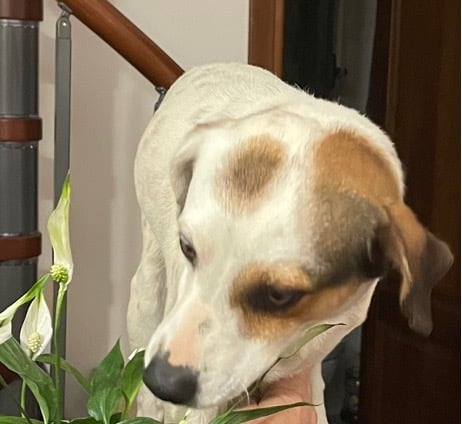Are you worried about your growing Peace Lily plants and whether the peace lily is toxic to dogs?
The peace lily is toxic to dogs, but the severity of poisonous symptoms will vary. If a dog eats the plant, they may experience gastrointestinal upset. Some dogs have been known to eat the entire plant. In this case, it causes vomiting and diarrhea, or even death. However, if the dog only nibbles on the leaves, the effects are usually milder.
This article will cover what makes the peace lily poisonous and what parts of the plant are toxic. It will also cover poisoning symptoms to look out for and how to treat those symptoms.
How Toxic is the Peace Lily?

Peace lilies are beautiful flowers that bloom during springtime and one of the most popular houseplants that are grown at home. But dogs should be kept away from areas where peace lilies grow because they may get sick.
There is a poisonous substance in them that can harm dogs if they eat them – calcium oxalate crystals.
These irritating compounds in the peace lily will irritate the mouth, throat, and other internal parts when ingested. Calcium oxalates will irritate because they’re needle-sharp crystals, called raphides. They will cause inflammation and pain.
These crystals are insoluble, so the pain and inflammation will persist, causing symptoms.
What Parts of the Peace Lily Are Toxic to Dogs?
All parts of peace lily plants are toxic to both dogs and cats, with the most dangerous part of the lily being the bulb. The peace lily’s leaves, flower petals, sepals, stems, pollen, and stamens are all poisonous.
The toxic crystals and substances are more concentrated in the bulb, so it’s more toxic than the other parts of the plant. To avoid your dog eating your plants, keep them away from her reach. Make sure your dog doesn’t dig them up by keeping them out of their reach or fencing them off.
If you’ve cut flowers as part of a bouquets, make sure the vases are out of reach of your dog. Check the area around the vases too, and pick up anything that has fallen from the plants before your dog does.
If you put your peace lilies in a vase with water, be careful with the water. The toxic substances from the plant will be in the water, so don’t let that water drop on the floor for your dogs and cats drink.
Keeping the vase on a stable surface is important too, so it doesn’t fall on the ground. This should be done with all houseplants if you have pets. Dispose of the water if there are no peace lilies in it.
Symptoms of Peace Lily Toxicity in Dogs
The list of peace lily poison symptoms is lengthy, including:
- Irritated Mouth
- Irritated Tongue
- Irritated Throat
- Vomiting
- Diarrhea
- Excessive Drooling
- Mouth Inflammation
- Breathing Issues
Some of the milder symptoms will go away on its own with time, but it may still be good to call a veterinarian, especially if problems persist.
Home remedies may be able to treat the milder symptoms, but your vet should be able to give you a better idea of what to do.

Peace Lily Poisoning Treatment for Dogs
If symptoms are mild and your dog isn’t in too much distress, check to see if any plant parts are still stuck in his mouth. Rinse the dog’s mouth out with water and encourage him to drink water. Ice chips can ease some of the discomfort caused.
If your dog is having a hard time breathing, take it to the veterinarian immediately. The vet will commonly prescribe anti-inflammation drugs and steroids.
Once the symptoms have passed and your dog’s condition has returned to normal, be sure to separate the dog and peace lily from now on.
Your dog will probably stay away from the peace lily plants from now on, but it’s still a good idea to take further precautions in the future.
Tips to Prevent Peace Lily Poisoning in Dogs
The key goal is to keep peace lilies out of your dog’s reach. If you want to use your garden for decoration, keep peace lilies out of the way of your dog. It’s also a good idea to keep peace lilies out from underfoot.
Here are some tips to keep the peace lily away from your dog:
- Don’t leave parts of the peace lily lying around on the ground or near your dog’s food bowl. Regularly sweep the floors for dropped leaves.
- Keep your peace lilies at least 6 feet above the ground or higher than your dog can jump.
- Don’t let your dog go hungry for too long. That will help keep your dog from looking for food. That can help prevent your dog from wanting to chew on the plants.
- Keep peace lilies well fenced off. Don’t allow dogs to wander into areas where they might find the peace lily plants.

Is Peace Lily Toxic to Dogs Final Thoughts
Peace lily poisoning is not very common among dogs. However, it does happen occasionally. Your pet could get poisoned by eating the flowers or stems, or by licking their paws after coming in contact with the plant.
Peace lily toxicity can cause serious health issues in dogs, so it’s always best to avoid them altogether. Keep peace lilies out of reach of your dog, and don’t let him come in contact with the plants.
Here are other articles you might be interested in to learn more about peace lilies:

